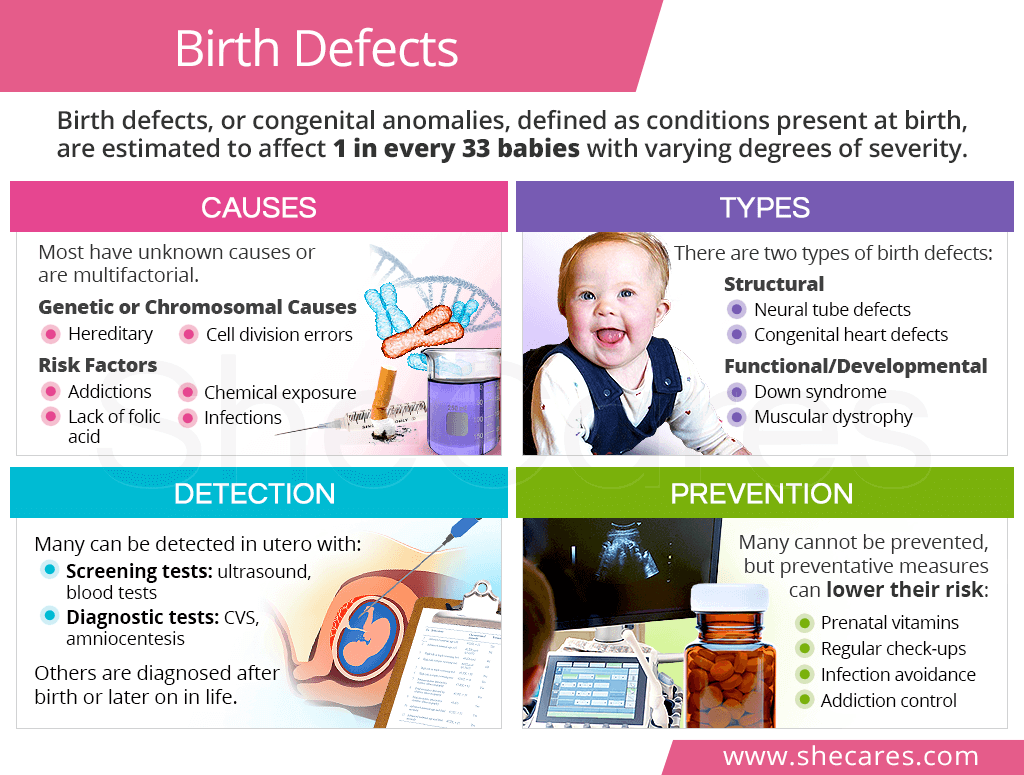What is a Birth Defect?
A birth defect, also known as a congenital anomaly, is defined as a condition present in a baby at birth.2
Birth defects can widely range in their severity from mild to severe. They can affect how babies look, function, and develop.
While birth defects can happen during any of the pregnancy stages, the majority occur in the first trimester, or the first three months.
Causes of Birth Defects
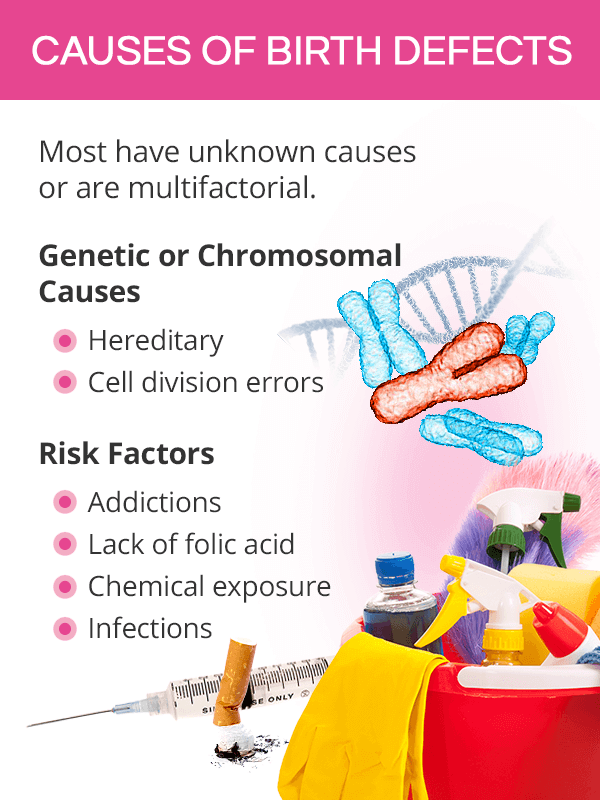
Most causes of birth defects are unknown. In many cases, a combination of factors can play a role and increase the risk of having a baby with birth defects. These risk factors and causes of birth defects are categorized as follows:
Genetic and Chromosomal Causes
Most genetic or chromosomal birth defects occur at the moment of conception. Genetic birth defects, like cystic fibrosis or sickle cell anemia, occur when an abnormal gene is passed down from one or both parents. Chromosomal congenital anomalies, like Down syndrome, happen due to mistakes in cell division, resulting in missing or extra chromosomes.
Non-Genetic Risk Factors of Birth Defects
A number of personal practices and environmental factors have been identified as risk factors of birth defects:
Lifestyle habits and behaviors
Smoking, drinking alcohol, and using illicit drugs as well as having poor prenatal care, especially lack of folic acidMedications
Some thyroid medications, certain antibiotics, high amounts of vitamin A, and others
Exposure to chemicals
Mercury, lead, pesticides, and insecticides
Infections during pregnancy
Untreated or newly acquired sexually transmitted diseases (STDs), rubella, chickenpox, toxoplasmosis, and listeriosis
Conditions before pregnancy
Obesity, diabetes, seizure disorders, and high blood pressure
Advanced maternal age
Being pregnant at 35 or older
Types of Birth Defects
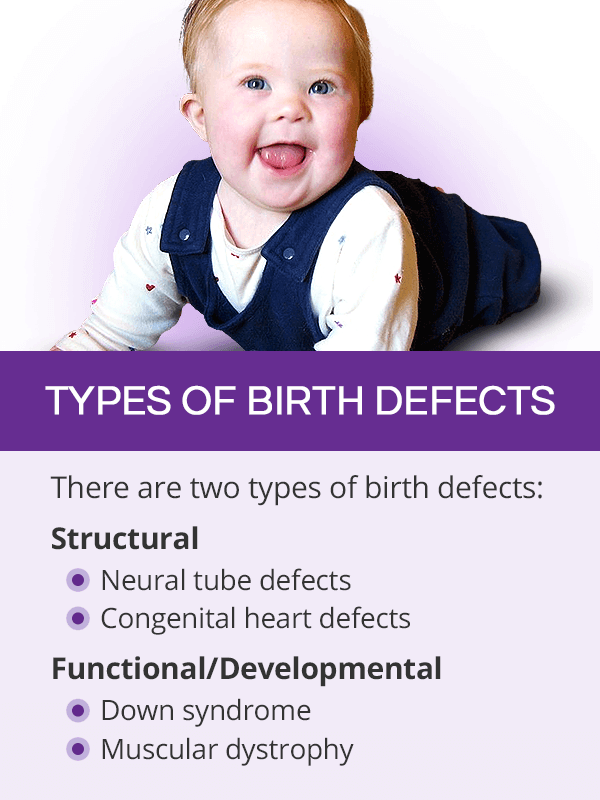
There are two types of birth defects: structural and functional/developmental.3 However, some birth defects can combine both types.
Structural Birth Defects
The structural type of birth defects relates to how the body is built, such as missing or malformed body parts. They include the following:
- Congenital heart defects
- Cleft lip or palate
- Neural tube defects, like spina bifida
- Clubfoot
- Gastroschisis
- Congenital dislocated hip
Functional or Developmental Birth Defects
The functional or developmental type of birth defects relate to how the body functions or develops, including its various parts or entire systems. These birth defects may result in the following disorders:
- Metabolic disorders, like phenylketonuria
- Nervous system disorders, like Down syndrome
- Sensory disorders, like blindness or deafness
- Degenerative disorders, like muscular dystrophy
Birth Defects Detection
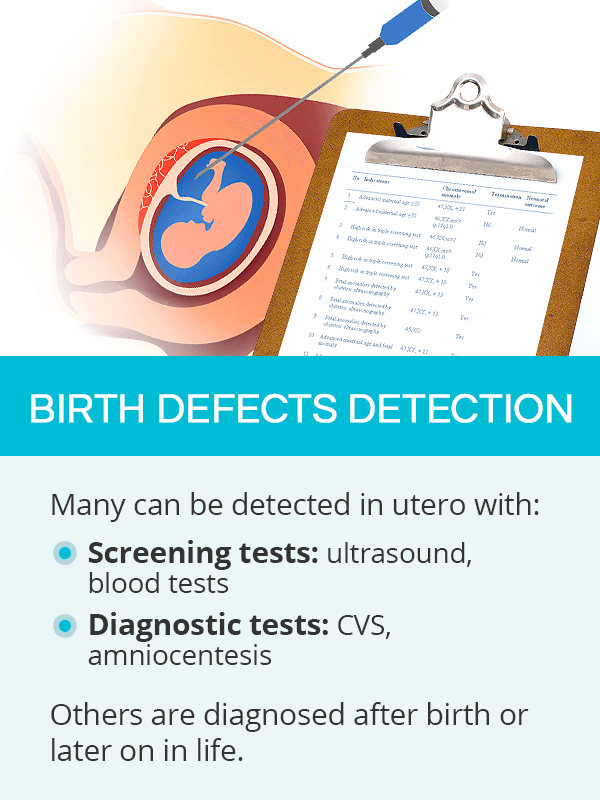
While many birth defects can be detected in utero, others are diagnosed at birth, in early childhood, or later on life.
A number of prenatal genetic tests aim to evaluate the risk of and diagnose birth defects during pregnancy, such as:
Screening tests, like pregnancy ultrasound and prenatal blood tests, are offered to all women to evaluate the risk of having a child with birth defects.
Diagnostic tests, like chorionic villus sampling (CVS) and amniocentesis, are used to rule out or confirm birth defects after the screening tests showed abnormal results, or a woman has risk factors for such defects.
It is worth noting that although effective in diagnosing congenital defects, the aforementioned tests do not check for all defects and cannot estimate their severity and extent, which can be properly evaluated after birth.
Preventing Birth Defects
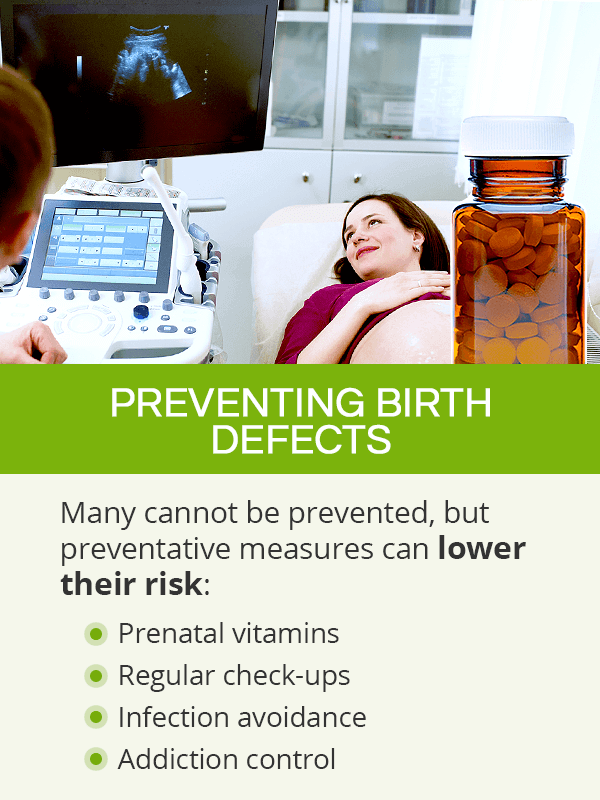
Although many types of birth defects cannot be prevented, there are a number of preventative measures and pregnancy precautions a woman can implement to decrease their risk and protect her baby's well-being.
Some of the best recommendations for preventing birth defects include the following:
- Keeping up with regular prenatal visits
- Starting prenatal vitamins at least a month before conceiving or as soon as confirmed pregnant
- Managing chronic conditions before getting pregnant
- Treating STDs and having protected sex to prevent new infections
- Checking on vaccination status to ensure proper immunity to preventable infectious diseases
- Reviewing all medications and herbal supplements with a doctor before pregnancy
- Maintaining a normal preconception weight and gaining pregnancy weight in a healthy way
- Quitting addictions before getting pregnant and avoiding alcohol, smoking, and drugs throughout pregnancy
- Avoiding exposure to harsh household chemicals and other environmental pollutants
Treatment of Congenital Anomalies
Although there is no cure for birth defects, several treatment options for some congenital defects are aimed at reducing their impact on the baby's health and levels of associated disability.
Specific types of treatment for congenital anomalies will depend on many factors, like the type of birth defect, its severity, and baby's age. Some interventions can take place when the baby is still in the womb, while others will be implemented right after birth or later on in life.
Therapy, including speech, occupational, and physical therapy
Medication, like those to strengthen the muscles or treat thyroid disorders
Surgery, like cleft palate or lip reconstruction, or corrective repairs for congenital heart defects
Assistive technology, like orthopedic braces or cochlear implants
Moreover, there is ongoing research on gene therapy for birth defects, which would involve replacing missing genes or replacing mutated ones with normal genes.
Key Takeaways
Birth defects, or congenital anomalies, affect about 120,000 babies in the United States alone every year.1 In the majority of the cases, their causes are unknown and believed to be multifactorial, including a combination of genetic roots, lifestyle practices, infections, and others. The several thousand existing birth defects usually fall into two types: structural birth defects, which affect how the body is built, and functional or developmental birth defects, which relate to how the body functions or develops. Their detection often takes place while the baby is still in the womb, while some can be diagnosed only after birth or later on in life. Many congenital anomalies cannot be prevented, but various preventative measures – such as taking folic acid during pregnancy, treating ongoing infections, or quitting addictions – can greatly reduce their risks. While birth defects cannot be cured, there are several treatments that can decrease their burden on a child's health, including therapies, medications, surgeries, and assistive devices.
Sources
- American Pregnancy Association. (n.d.). Birth Defects & Disorders. Retrieved September 16, 2019 from https://americanpregnancy.org/birth-defects/
- Better Health Channel. (2018). Birth defects explained. Retrieved September 16, 2019 from https://www.betterhealth.vic.gov.au/health/conditionsandtreatments/birth-defects
- Better Health Channel. (2018). Drugs, medication and birth defects. Retrieved September 16, 2019 from https://www.betterhealth.vic.gov.au/health/conditionsandtreatments/drugs-medication-and-birth-defects
- BMJ. (2017). Etiology and clinical presentation of birth defects: population based study. Retrieved September 16, 2019 from https://www.ncbi.nlm.nih.gov/pmc/articles/PMC5448402/
- Healthy Children. (2015). Congenital Abnormalities. Retrieved September 16, 2019 from https://www.healthychildren.org/English/health-issues/conditions/developmental-disabilities/Pages/Congenital-Abnormalities.aspx
- Eunice Kennedy Shriver National Institute of Child Health and Human Development. (2017). What are the treatments for birth defects? Retrieved September 16, 2019 from https://www.nichd.nih.gov/health/topics/birthdefects/conditioninfo/treatment
- March of Dimes. (2006). Global Report on Birth Defects. Retrieved September 16, 2019 from https://www.marchofdimes.org/global-report-on-birth-defects-the-hidden-toll-of-dying-and-disabled-children-full-report.pdf
- March of Dimes. (2017). Prescription Medicine During Pregnancy. Retrieved September 16, 2019 from https://www.marchofdimes.org/pregnancy/prescription-medicine-during-pregnancy.aspx
- Medline Plus. (2019). Birth Defects. Retrieved September 16, 2019 from https://medlineplus.gov/birthdefects.html
- Mother to Baby. (n.d.). Medications: Fact Sheets. Retrieved September 16, 2019 from https://mothertobaby.org/fact-sheets-parent/
Footnotes:
- CDC. (2018). What are Birth Defects? Retrieved September 16, 2019 from https://www.cdc.gov/ncbddd/birthdefects/facts.html
- American College of Obstetricians and Gynecologists. (2018). Reducing Risks of Birth Defects. Retrieved September 16, 2019 from https://www.acog.org/Patients/FAQs/Reducing-Risks-of-Birth-Defects
- Eunice Kennedy Shriver National Institute of Child Health and Human Development. (2017). What are the types of birth defects? Retrieved September 16, 2019 from https://www.nichd.nih.gov/health/topics/birthdefects/conditioninfo/types
